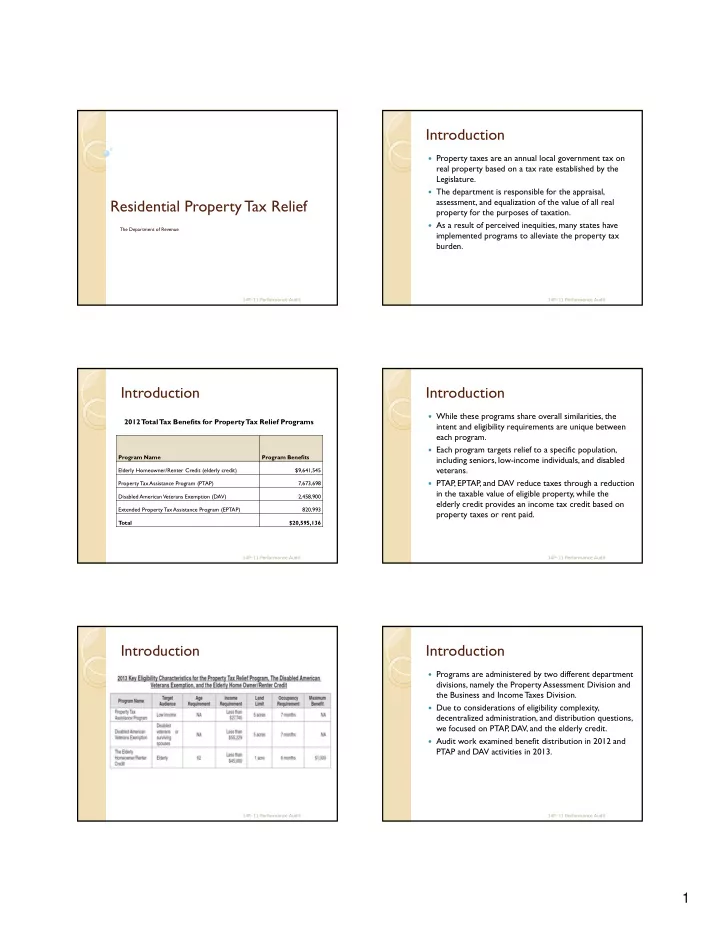

Introduction Property taxes are an annual local government tax on real property based on a tax rate established by the Legislature. The department is responsible for the appraisal, Residential Property Tax Relief assessment, and equalization of the value of all real property for the purposes of taxation. As a result of perceived inequities, many states have The Department of Revenue implemented programs to alleviate the property tax burden. 14P-11 Performance Audit 14P-11 Performance Audit Introduction Introduction While these programs share overall similarities, the 2012 T otal Tax Benefits for Property Tax Relief Programs intent and eligibility requirements are unique between each program. Each program targets relief to a specific population, Program Name Program Benefits including seniors, low-income individuals, and disabled veterans. Elderly Homeowner/Renter Credit (elderly credit) $9,641,545 PTAP, EPTAP, and DAV reduce taxes through a reduction Property Tax Assistance Program (PTAP) 7,673,698 in the taxable value of eligible property, while the Disabled American Veterans Exemption (DAV) 2,458,900 elderly credit provides an income tax credit based on Extended Property Tax Assistance Program (EPTAP) 820,993 property taxes or rent paid. T otal $20,595,136 14P-11 Performance Audit 14P-11 Performance Audit Introduction Introduction Programs are administered by two different department divisions, namely the Property Assessment Division and the Business and Income Taxes Division. Due to considerations of eligibility complexity, decentralized administration, and distribution questions, we focused on PTAP, DAV, and the elderly credit. Audit work examined benefit distribution in 2012 and PTAP and DAV activities in 2013. 14P-11 Performance Audit 14P-11 Performance Audit 1
Findings and Recommendations Occupancy Verification Audit work examined how the department administers PTAP and DAV applicants are required to own and property tax relief programs, including how relief is occupy the residence for at least seven months annually. distributed. The department generally relies on applicants to self- affirm occupancy and a review of supporting documentation. ◦ Verify occupancy requirements. ◦ Verify income requirements. In 2013, 23 PTAP and 26 DAV granted applicants did not occupy their properties for the required term resulting ◦ Ensure taxpayers receive relief on eligible property. in nearly $50,000 in benefits granted in error. ◦ Ensure taxpayers receive relief based on qualifying income. ◦ Examine relief distribution. 14P-11 Performance Audit 14P-11 Performance Audit Income Verification Income Verification Participants provide supporting income documentation which the department reviews and determines reportable income. However, income documentation is inconsistently reviewed and interpreted. There are significant discrepancies in the amount of income reported by taxpayers within the department. 14P-11 Performance Audit 14P-11 Performance Audit Qualifying Property Qualifying Income State law places limits on the type and amount of Based on a series of qualifying income tiers, the property eligible for relief. department selects a reduced tax rate. PTAP limits relief to $100,000 of a property’s TMV and The department does not consistently ensure that five acres; DAV limits relief to five acres. taxpayers are receiving the correct reduced tax rate based on their qualifying income. Audit work identified nearly $30,000 in benefits received by taxpayers on ineligible property. Audit work identified 325 PTAP and 15 DAV granted applicants in 2013 who did not receive the appropriate tax rate reduction totaling nearly $100,000 in benefit errors. 14P-11 Performance Audit 14P-11 Performance Audit 2
Relief Distribution Relief Distribution Are there taxpayers accessing multiple property tax relief programs? How is property tax relief used and distributed across the state? How does participation in relief programs compare with certain population data for participants? 14P-11 Performance Audit 14P-11 Performance Audit Relief Distribution Relief Distribution Should property tax programs be more closely coordinated? Are taxpayers obtaining relief in excess of their property tax liability? Property tax relief efforts in Montana are generally fragmented and uncoordinated, with disparate and often confusing eligibility requirements making it challenging for individual taxpayers to interpret and the Department of Revenue to administer 14P-11 Performance Audit 14P-11 Performance Audit Relief Distribution It is currently unclear what factors impact participation. The department has a role to secure a fair, just, and equitable of all taxable property between taxpayers. Property tax relief provides assistance to those Questions? individuals whom the current valuation process may disproportionally impact. 14P-11 Performance Audit 14P-11 Performance Audit 3
Recommend
More recommend